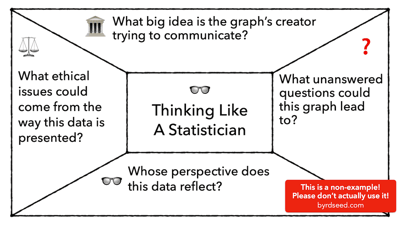I used a Depth and Complexity Frame like this with my math students. Let’s look at how we could improve this.

Some problems:
- It asks four unrelated questions. I want to build a sequence of questions that climbs Bloom’s Taxonomy.
- Most of the questions are naturally answered with “yes” or “no” or a list. Questions should naturally prompt interesting answers.
- The questions are wordy and complicated. They should be easy to understand.
It’s always best to start with one good question and build on it. I’d pick just one of these questions to work with.
Fixing the Perspectives Question
Perhaps I’ll build my sequence around this question:
👓 Whose perspective does this data reflect?
This is really wordy. It’s poorly written. Let’s revise it!
Confusing: Whose perspective does this data reflect?
Clearer: Who made this graph?
Much clearer, right? It also exposes how simple the question is. It’s a low-level, identify question. It would be ok to start with this question, but we cannot stop here. Let’s build a sequence around it.
I’d probably want to ask:
- Who made this graph?
- Who might disagree with this graph?
- How would they want to show the data differently? Create their version.
- Which version do you think is more reasonable?
- Create a third way of presenting the data in a way that neither person would like.
See how we’re climbing up Blooms? Each step builds on the previous step. Will every student get to every step? Of course not. That’s differentiation!
So rather than having four, unrelated, untested questions, I want to pick one question and make it great. Then I want to build on that one question to develop a sequence.
Or, Fixing The Ethics Question
Or we might pick this question to build on:
What ⚖️ ethical issues could come from the way this data is presented?
This question is way too wordy. So, first, I’d clarify my question.
Confusing: What ⚖️ ethical issues could come from the way this data is presented?
Clearer: Is this graph ⚖️ misleading?
Much easier to understand, right? This is what happens when we revise! But, it’s still not a great question. See what happens when I change it a bit:
Confusing: What ⚖️ ethical issues could come from the way this data is presented?
Okay: Is this graph ⚖️ misleading?
Better: What is the ⚖️ biggest problem with this graph?
Ah ha! See how this version of the question prompts a more interesting answer? Now, I’d want to build a sequence out of this question. And you can read more about that in my Bad Graphs task.

